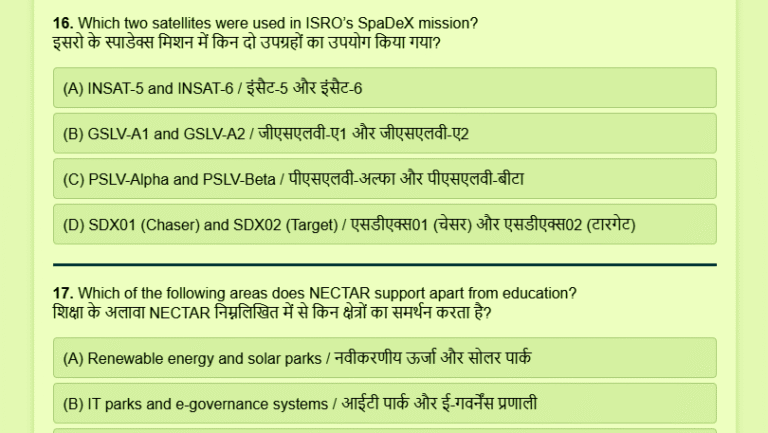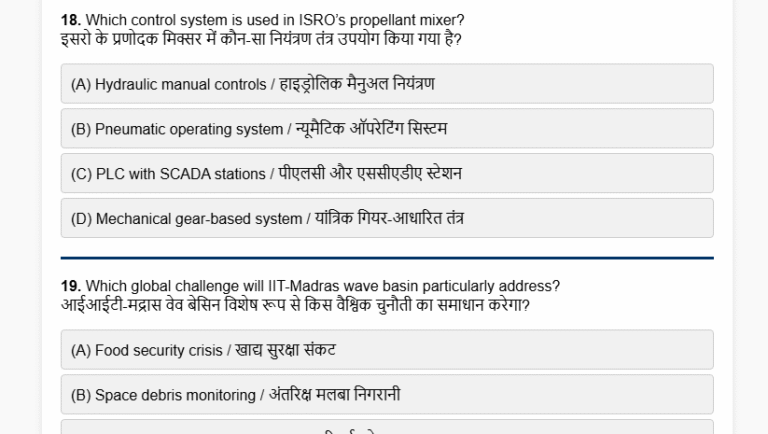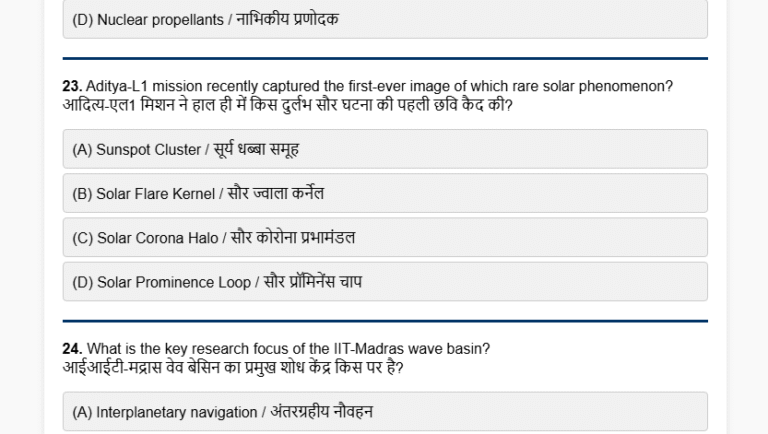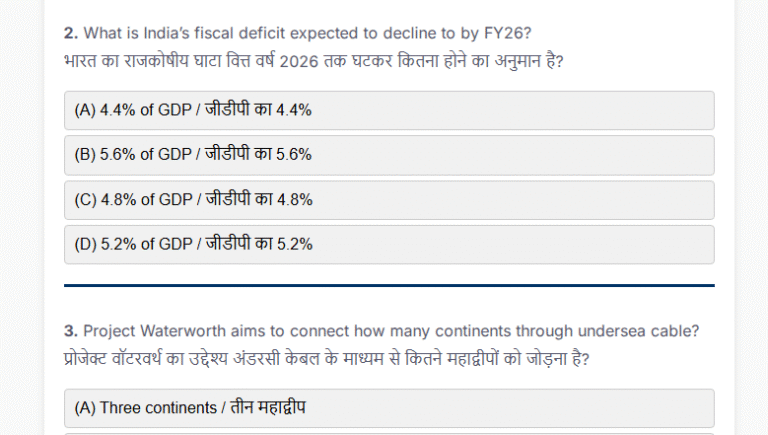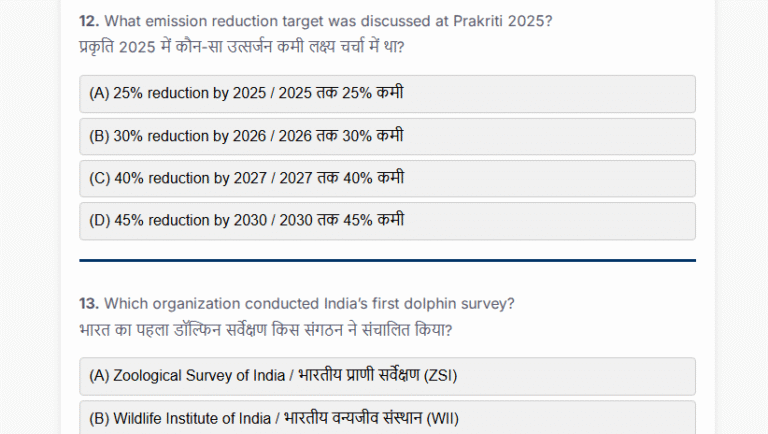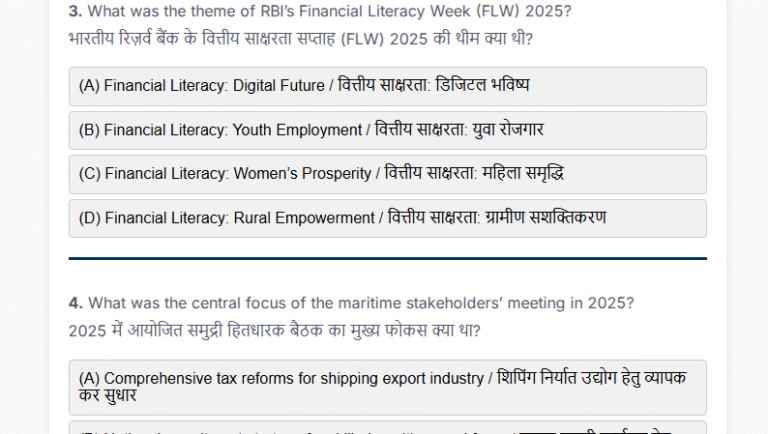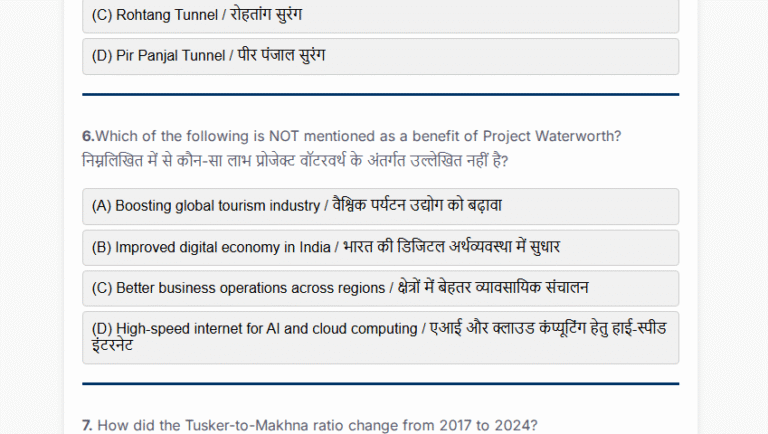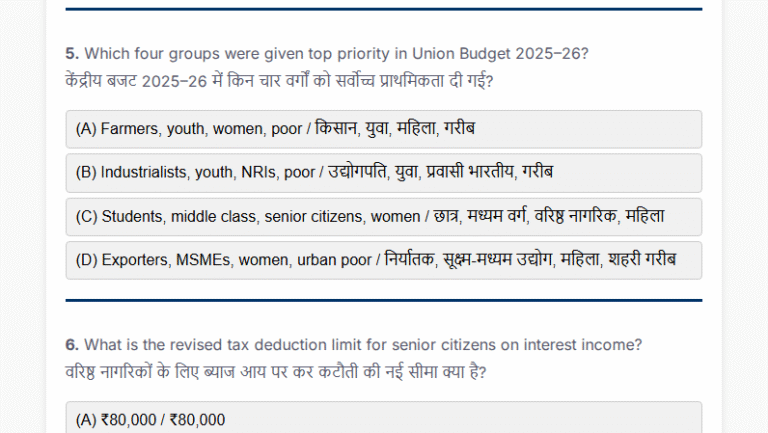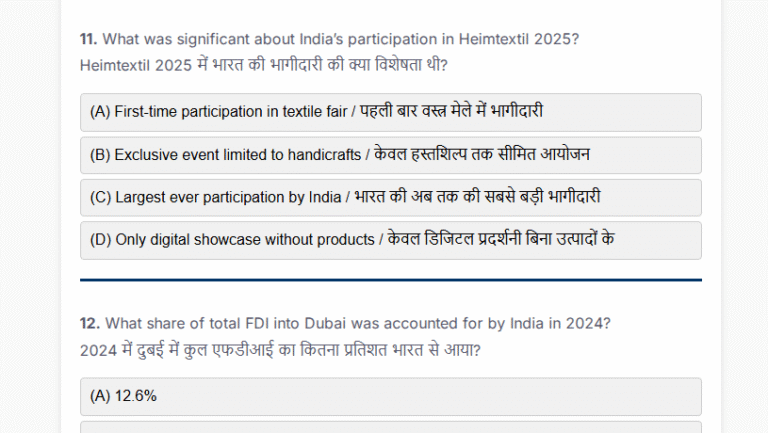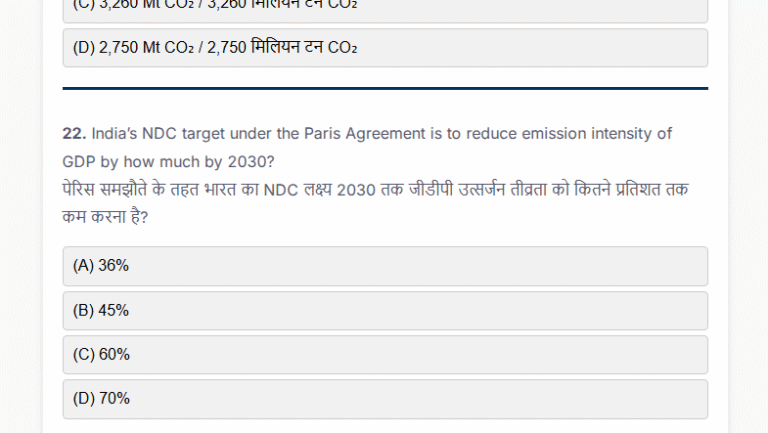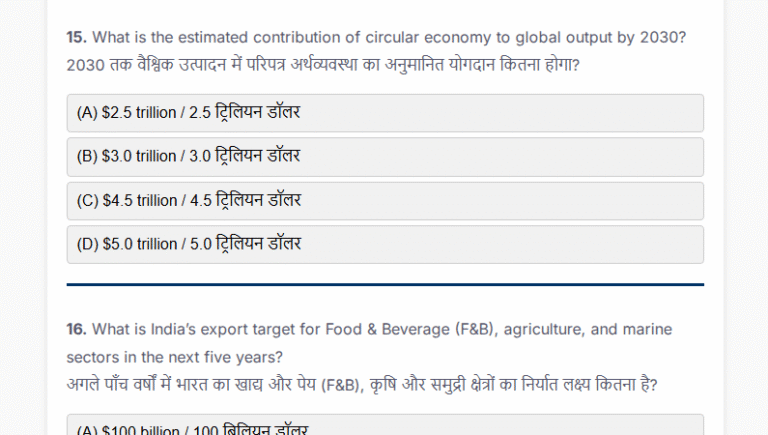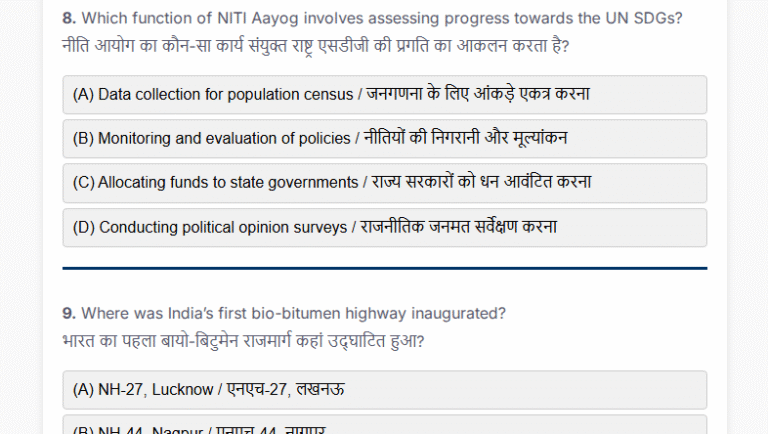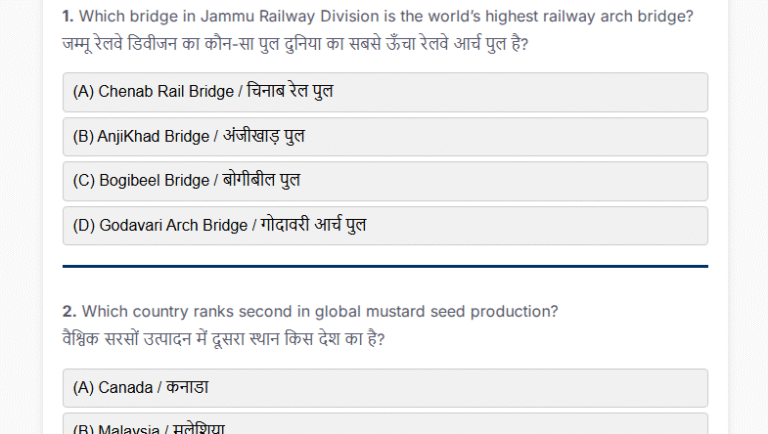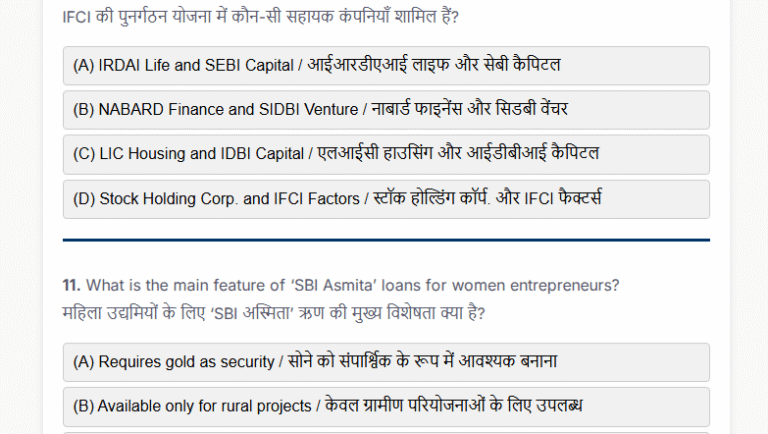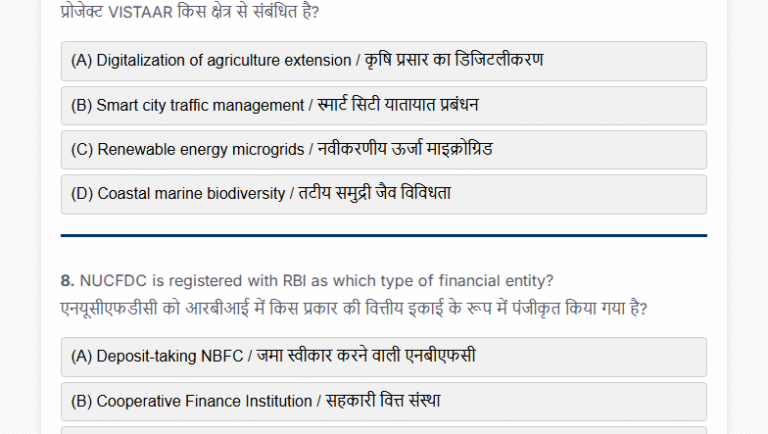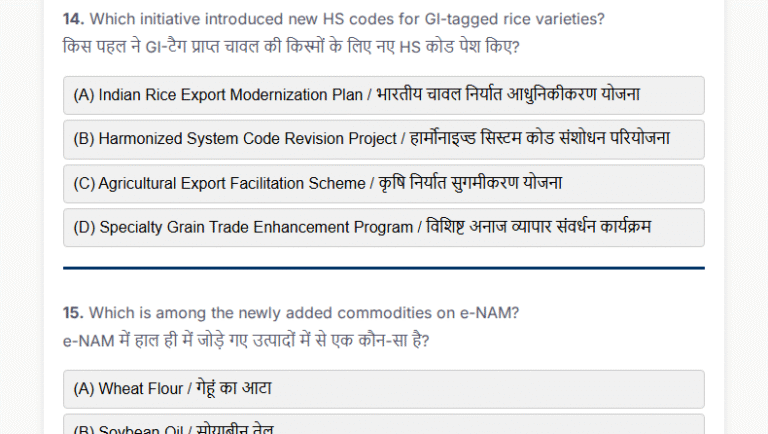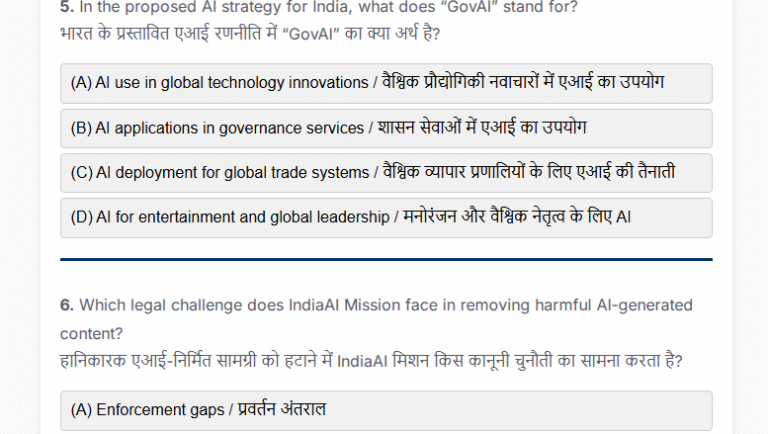Current Affairs Today MCQs (15 Nov 2024)
1. What is a significant challenge facing India’s nutraceutical industry?
(A) Shortage of raw materials
(B) Lack of pharmaceutical expertise
(C) Regulatory clarity and scientific validation
(D) Dominance of India in the global market
The correct answer is (c) Regulatory clarity and scientific validation
India’s nutraceutical industry faces challenges including unclear regulations and a need for scientific studies on traditional ingredients. Without regulatory clarity, it’s challenging to support the sector effectively. Additionally, scientific validation is necessary to ensure traditional ingredients meet global standards and gain wider acceptance in the international market.
2. Which region holds the largest share of the global nutraceutical market?
(A) India
(B) Africa
(C) Australia
(D) North America, Japan, and Europe
The correct answer is (D) North America, Japan, and Europe
The United States, Japan, and Europe dominate the global nutraceutical market, accounting for over 90% of the total share. While India has a promising industry with rich resources, its current market share remains below 2%. However, India’s nutraceutical market is projected to grow significantly, aiming to reach USD 18 billion by 2025.
3. Allulose is gaining popularity as a sugar substitute because:-
(A) It is sweeter than sugar
(B) It has a bitter aftertaste
(C) It lacks the bitter aftertaste found in some sweeteners
(D) It is only present in artificial foods
The correct answer is (C)It lacks the bitter aftertaste found in some sweeteners
Allulose is about 70% as sweet as regular sugar but doesn’t have the bitter aftertaste found in certain other sweeteners like aspartame. This characteristic, along with its potential benefits in controlling blood sugar and aiding weight loss, makes it a strong alternative to other sugar substitutes.
4. Which organization recently advised against the use of non-sugar sweeteners for weight control?
(A) World Health Organization (WHO)
(B) Food and Agriculture Organization (FAO)
(C) International Sugar Organization (ISO)
(D) National Institutes of Health (NIH)
The correct answer is (A) World Health Organization (WHO)
In 2023, the World Health Organization issued guidelines advising against using non-sugar sweeteners for weight control, highlighting potential long-term undesirable effects. Additionally, WHO classified aspartame as a possible carcinogen but indicated it is safe to consume within established limits, emphasizing caution in artificial sweetener use.
5. What is a unique feature of flying boats compared to floatplanes?
(A) They require traditional runways for takeoff and landing
(B) They have floats attached to the wings
(C) They have a hull that enables them to land on water
(D) They can only land on land
The correct answer is (C) They have a hull that enables them to land on water
Flying boats are a type of seaplane with a boat-like hull that allows them to take off and land on water directly, without needing separate floats. Floatplanes, in contrast, have floats attached to the wings or fuselage. Both types of seaplanes offer versatility by accessing remote areas without traditional runways.
6. Which of the following is a significant advantage of seaplanes?
(A) They can access remote locations with limited infrastructure
(B) They are more fuel-efficient than traditional airplanes
(C) They are primarily used for transatlantic flights
(D) They have minimal maintenance requirements
The correct answer is (A) They can access remote locations with limited infrastructure
Seaplanes are ideal for reaching remote areas that lack traditional airports or runways. Their ability to take off and land on water reduces infrastructure needs, making them versatile for use in regions with limited access. This characteristic has made them popular in areas with numerous lakes and rivers or along extensive coastlines.
7. What was the objective behind India’s first seaplane project launched in Gujarat?
(A) To develop seaplanes for international travel
(B) To research seaplane technology for defense use
(C) To replace traditional aircraft with seaplanes entirely
(D) To boost regional air connectivity and promote tourism
The correct answer is (D) To boost regional air connectivity and promote tourism
India’s first seaplane project, launched in Gujarat, aimed to enhance regional air connectivity and promote tourism. By connecting the Sabarmati Riverfront in Ahmedabad to the Statue of Unity in Kevadia, the project showcased the potential of water-based aviation in India. Though initially suspended due to high costs, it reflects India’s interest in integrating seaplanes into its tourism and transport sectors.
8. What is the goal of the recent guidelines introduced by the Union Minister for Civil Aviation for seaplane operations?
(A) To expand traditional airport infrastructure along coastlines
(B) To integrate seaplane operations into India’s aviation network
(C) To launch seaplanes exclusively for international tourism
(D) – To reduce coastline usage for aviation purposes
The correct answer is (B) To integrate seaplane operations into India’s aviation network
The new guidelines for seaplane operations introduced by the Union Minister for Civil Aviation aim to integrate seaplanes into India’s broader aviation landscape. Leveraging India’s 7,517 km coastline and its extensive river and lake network, the guidelines encourage seaplane use to improve connectivity and expand tourism opportunities.
9. Which country recently emerged as a prominent testing ground for the sweetener allulose?
(A) Japan
(B) China
(C) United States
(D) South Korea
The correct answer is (D) South Korea
South Korea has become a significant testing ground for the sweetener allulose, which is gaining traction as a promising sugar substitute due to its lower caloric content and mild sweetness without a bitter aftertaste. Unlike other non-sugar sweeteners, allulose is popular as it offers a similar experience to sugar, aiding its acceptance among consumers seeking alternatives to sugar.
10. What is one potential benefit of CO₂-to-methanol conversion technology?
(A) Permanent CO₂ elimination from the atmosphere
(B) Carbon Capture and Utilization (CCU)
(C) Immediate reduction of fossil fuel consumption
(D) Complete replacement of gasoline in the market
The correct answer is (B) Carbon Capture and Utilization (CCU)
CO₂-to-methanol technology helps utilize captured CO₂, reducing its atmospheric impact. Methanol produced can serve as a renewable fuel, support energy storage, and act as a versatile feedstock for various chemical industries. However, while CCU reduces CO₂ emissions, it doesn’t permanently eliminate CO₂ from the atmosphere.
11. How does India’s agro-climatic diversity benefit its nutraceutical industry?
(A) Supports cultivation of various medicinal plants
(B) Increases demand for imports of herbal products
(C) Reduces need for scientific studies
(D) Allows India to dominate the global nutraceutical market
The correct answer is (A) Supports cultivation of various medicinal plants
India’s diverse agro-climatic zones support the cultivation of a wide range of medicinal plants essential to the nutraceutical industry. This diversity provides India with a unique advantage in developing nutraceutical products based on traditional health practices and ingredients, though scientific validation is needed to reach international standards..
12. Why is allulose considered an emerging alternative to traditional sweeteners?
(A) It is naturally found in most common foods
(B) It has no effect on blood sugar levels
(C) It is 100% sweeter than regular sugar
(D) It lacks the bitter aftertaste of other sweeteners
The correct answer is (D) It lacks the bitter aftertaste of other sweeteners
Allulose is approximately 70% as sweet as regular sugar and lacks the bitter aftertaste often found in artificial sweeteners like aspartame. This makes it an appealing alternative, especially for consumers who desire a sweetener that closely mimics the taste of sugar without unwanted aftertastes.
13. What unique property of seaplanes makes them suitable for operations in remote areas?
(A) They can take off and land on both water and traditional runways
(B) They are faster than most conventional aircraft
(C) They require no maintenance
(D) They are exclusively used for international flights
The correct answer is (A) They can take off and land on both water and traditional runways
Seaplanes can access remote locations by taking off and landing on water, and amphibious seaplanes can also operate from traditional runways. This versatility enables them to serve areas with limited infrastructure, making them ideal for tourism, regional connectivity, and emergency operations in isolated regions.
14. Which of the following factors has contributed to South Korea’s emergence as a top testing ground for allulose?
(A) Lack of domestic sugar production
(B) Allulose’s effectiveness in blood sugar control and weight loss
(C) Strict bans on other sweeteners
(D) Exclusive availability of allulose in South Korea
The correct answer is (B) Allulose’s effectiveness in blood sugar control and weight loss
South Korea has become a prominent testing ground for allulose because of its benefits in blood sugar management and potential for aiding weight loss. Its characteristics, such as reduced calorie content and lack of aftertaste, make it a suitable alternative for consumers interested in healthier dietary options.
15. What was one major consequence of the fall of the Berlin Wall in 1989?
(A) Strengthening of Soviet influence
(B) Beginning of the European Union
(C) Initiation of German reunification
(D) Construction of new barriers in Europe
The correct answer is (C) Initiation of German reunification
The fall of the Berlin Wall on November 9, 1989, marked the start of Germany’s reunification, formally completed on October 3, 1990. This event also signified the beginning of the end of the Cold War, leading to the expansion of democracy and market economies in Eastern Europe and reducing Soviet influence.
16. What role does traditional knowledge, such as Ayurveda, play in India’s nutraceutical industry?
(A) It eliminates the need for product testing
(B) It contributes unique ingredients and formulations
(C) It limits market expansion in developed countries
(D) It discourages modern pharmaceutical developments
The correct answer is (B) It contributes unique ingredients and formulations
Traditional knowledge, especially Ayurveda, allows India’s nutraceutical industry to offer unique ingredients, such as ashwagandha and curcumin, which are rooted in Indian health practices. This traditional knowledge gives India a competitive advantage in nutraceuticals, though scientific validation is often necessary to meet global regulatory standards.
17. Which of the following is NOT a challenge faced by India’s nutraceutical industry?
(A) Lack of scientific validation for traditional ingredients
(B) Need for regulatory clarity
(C) Investment in research and development
(D) Dominance of India in the global market
The correct answer is (D) Dominance of India in the global market
India’s current market share in the global nutraceutical industry is below 2%, so it is not a dominant player. The industry’s main challenges include regulatory clarity, scientific validation of traditional ingredients, and the need for increased research and development. These areas are crucial for India to strengthen its position in the international market.
18. Why has the World Health Organization advised caution with non-sugar sweeteners?
(A) They are more addictive than sugar
(B) Potential long-term health risks
(C) They offer no taste similarity to sugar
(D) High caloric content
The correct answer is (B) Potential long-term health risks
The WHO issued guidelines advising against the use of non-sugar sweeteners for weight control due to potential undesirable long-term health effects. WHO also classified aspartame as a “possible carcinogen,” but stated it is safe within specific intake limits. These cautions highlight the need for careful use of artificial sweeteners in diets.
19. What is the purpose of India’s CO₂-to-methanol technology project at NTPC’s Vindhyachal plant?
(A) To synthesize methanol for renewable fuel production
(B) To capture CO₂ from automobiles
(C) To produce CO₂ for industrial applications
(D) To release captured CO₂ into the atmosphere
The correct answer is (A) To synthesize methanol for renewable fuel production
NTPC’s project at the Vindhyachal plant synthesizes methanol by capturing CO₂ from industrial flue gases and combining it with hydrogen produced from electrolysis. This innovation aims to create a sustainable fuel source, utilizing CO₂ in a way that can help reduce its environmental impact and contribute to energy storage solutions.
20. What unique feature allows Cyanobacteria to significantly contribute to carbon sequestration?
(A) Their ability to decompose organic matter rapidly
(B) Their ability to release large amounts of oxygen at night
(C) Their rapid reproduction rate in desert conditions
(D) Their capacity to photosynthesize like plants
The correct answer is (D) Their capacity to photosynthesize like plants
Cyanobacteria, also known as “blue-green algae,” are photosynthetic microorganisms that convert CO₂ into organic material, similar to plants. This photosynthetic ability makes them valuable for carbon sequestration, as they absorb CO₂ and can potentially store it at the bottom of water bodies, contributing to long-term carbon capture efforts.
_
Set 20 Quarterly CA 2025 Jan to March IMPORTANT INSTRUCTIONS This test consists of 25 questions.At…
Set 19 Quarterly CA 2025 Jan to March IMPORTANT INSTRUCTIONS This test consists of 25 questions.At…
Set 18 Quarterly CA 2025 Jan to March IMPORTANT INSTRUCTIONS This test consists of 25 questions.At…
Set 17 Quarterly CA 2025 Jan to March IMPORTANT INSTRUCTIONS This test consists of 25 questions.At…
Set 16 Quarterly CA 2025 Jan to March IMPORTANT INSTRUCTIONS This test consists of 25 questions.At…
Set 15 Quarterly CA 2025 Jan to March IMPORTANT INSTRUCTIONS This test consists of 25 questions.At…
Set 14 Quarterly CA 2025 Jan to March IMPORTANT INSTRUCTIONS This test consists of 25 questions.At…
Set 13 Quarterly CA 2025 Jan to March IMPORTANT INSTRUCTIONS This test consists of 25 questions.At…
Set 12 Quarterly CA 2025 Jan to March IMPORTANT INSTRUCTIONS This test consists of 25 questions.At…
Set 11 Quarterly CA 2025 Jan to March IMPORTANT INSTRUCTIONS This test consists of 25 questions.At…
Set 10 Quarterly CA 2025 Jan to March IMPORTANT INSTRUCTIONS This test consists of 25 questions.At…
Set 9 Quarterly CA 2025 Jan to March IMPORTANT INSTRUCTIONS This test consists of 25 questions.At…
Set 8 Quarterly CA 2025 Jan to March IMPORTANT INSTRUCTIONS This test consists of 25 questions.At…
Set 7 Quarterly CA 2025 Jan to March IMPORTANT INSTRUCTIONS This test consists of 25 questions.At…
Set 6 Quarterly CA 2025 Jan to March IMPORTANT INSTRUCTIONS This test consists of 25 questions.At…
Set 5 Quarterly CA 2025 Jan to March IMPORTANT INSTRUCTIONS This test consists of 25 questions.At…
Set 4 Quarterly CA 2025 Jan to March IMPORTANT INSTRUCTIONS This test consists of 25 questions.At…
Set 2 Quarterly CA 2025 Jan to March IMPORTANT INSTRUCTIONS This test consists of 25 questions.At…
Set 3 Quarterly CA 2025 Jan to March IMPORTANT INSTRUCTIONS This test consists of 25 questions.At…
Test Series of 1st Quarterly Current Affairs 2025 प्रथम त्रैमासिक करेंट अफेयर्स 2025 की टेस्ट सीरीज़…
Current Affairs Today MCQs (26 Nov 2024) 1. What is the primary purpose of the Rejang Dewa dance in…
Current Affairs Today MCQs (25 Nov 2024) 1. What feature distinguishes African penguins from other…
Current Affairs Today MCQs (24 Nov 2024) 1. Which of the following is a distinctive feature of…
Current Affairs Today MCQs (23 Nov 2024) 1. What is the target adaptation finance commitment for the…
Current Affairs Today MCQs (22 Nov 2024) 1. How many youth are targeted for internships under the PM…
Current Affairs Today MCQs (21 Nov 2024) 1. Which is the funding ratio for PM-JAY between the Centre…
Current Affairs Today MCQs (20 Nov 2024) 1. Who is eligible for the Ayushman Vay Vandana Card? (A)…
Current Affairs Today MCQs (5 Nov 2024) 1. What conditions contribute to the formation of the DANA…
Current Affairs Today MCQs (4 Nov 2024) 1. What is the primary function of Israel’s Iron Beam…
Current Affairs Today MCQs (3 Nov 2024) 1. To whom was the Balfour Declaration addressed? (A) David…


